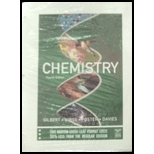
(a)
Interpretation: The allowed combinations of quantum numbers from the given combinations are to be stated.
Concept introduction: There are four quantum numbers that indicates the size, energy and shape of an atomic orbital. The quantum number
To determine: If the given combination of quantum numbers is allowed.
(a)
Answer to Problem 7.90QP
Solution
The combination of quantum number is allowed.
Explanation of Solution
Explanation
Explanation
The given combination of quantum numbers is
The possible values of
Therefore, the value of
(b)
To determine: If the given combination of quantum numbers is allowed.
(b)
Answer to Problem 7.90QP
Solution
The combination of quantum number is allowed.
Explanation of Solution
Explanation
The given combination of quantum numbers is
The possible values of
Therefore, the value of
(c)
To determine: If the given combination of quantum numbers is allowed.
(c)
Answer to Problem 7.90QP
Solution
The combination of quantum number is not allowed.
Explanation of Solution
Explanation
The given combination of quantum numbers is
The given value of
(d)
To determine: If the given combination of quantum numbers is allowed.
(d)
Answer to Problem 7.90QP
Solution
The combination of quantum number is not allowed.
Explanation of Solution
Explanation
The given combination of quantum numbers is
The possible values of
Conclusion
In the given combinations of quantum numbers, options (a) and (b) correspond to the allowed combinations.
Want to see more full solutions like this?
Chapter 7 Solutions
Chemistry
 ChemistryChemistryISBN:9781305957404Author:Steven S. Zumdahl, Susan A. Zumdahl, Donald J. DeCostePublisher:Cengage Learning
ChemistryChemistryISBN:9781305957404Author:Steven S. Zumdahl, Susan A. Zumdahl, Donald J. DeCostePublisher:Cengage Learning ChemistryChemistryISBN:9781259911156Author:Raymond Chang Dr., Jason Overby ProfessorPublisher:McGraw-Hill Education
ChemistryChemistryISBN:9781259911156Author:Raymond Chang Dr., Jason Overby ProfessorPublisher:McGraw-Hill Education Principles of Instrumental AnalysisChemistryISBN:9781305577213Author:Douglas A. Skoog, F. James Holler, Stanley R. CrouchPublisher:Cengage Learning
Principles of Instrumental AnalysisChemistryISBN:9781305577213Author:Douglas A. Skoog, F. James Holler, Stanley R. CrouchPublisher:Cengage Learning Organic ChemistryChemistryISBN:9780078021558Author:Janice Gorzynski Smith Dr.Publisher:McGraw-Hill Education
Organic ChemistryChemistryISBN:9780078021558Author:Janice Gorzynski Smith Dr.Publisher:McGraw-Hill Education Chemistry: Principles and ReactionsChemistryISBN:9781305079373Author:William L. Masterton, Cecile N. HurleyPublisher:Cengage Learning
Chemistry: Principles and ReactionsChemistryISBN:9781305079373Author:William L. Masterton, Cecile N. HurleyPublisher:Cengage Learning Elementary Principles of Chemical Processes, Bind...ChemistryISBN:9781118431221Author:Richard M. Felder, Ronald W. Rousseau, Lisa G. BullardPublisher:WILEY
Elementary Principles of Chemical Processes, Bind...ChemistryISBN:9781118431221Author:Richard M. Felder, Ronald W. Rousseau, Lisa G. BullardPublisher:WILEY





